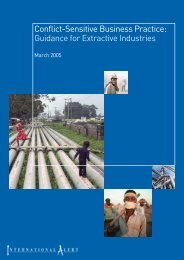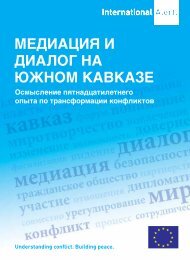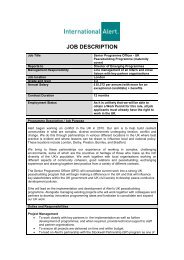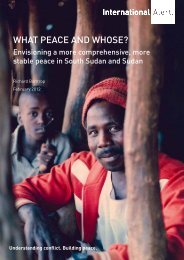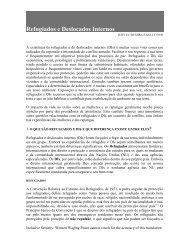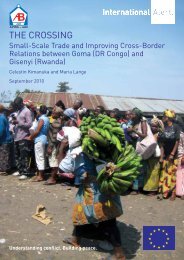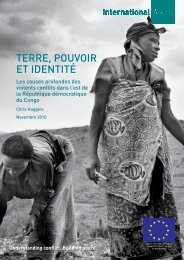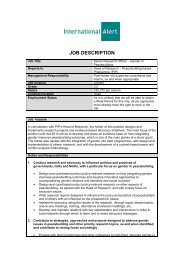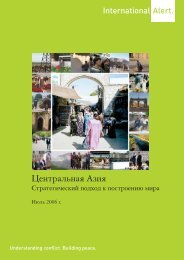The complexiTy of resource governance in a conTexT of sTaTe ... - Ipis
The complexiTy of resource governance in a conTexT of sTaTe ... - Ipis
The complexiTy of resource governance in a conTexT of sTaTe ... - Ipis
You also want an ePaper? Increase the reach of your titles
YUMPU automatically turns print PDFs into web optimized ePapers that Google loves.
<strong>The</strong> complexity <strong>of</strong> <strong>resource</strong> <strong>governance</strong> <strong>in</strong> a context <strong>of</strong> state fragility: An analysis <strong>of</strong> the m<strong>in</strong><strong>in</strong>g sector <strong>in</strong> the Kivu h<strong>in</strong>terlands<br />
49<br />
– government and non-government alike – <strong>in</strong> the two territories. It seems that greater government<br />
presence alone does not necessarily correlate with more responsible, efficient and transparent<br />
management <strong>of</strong> the sector. <strong>The</strong> level <strong>of</strong> taxation, both formal and <strong>in</strong>formal, is far higher <strong>in</strong> the<br />
surveyed areas <strong>of</strong> Mambasa than <strong>in</strong> Bafwasende – as is the number <strong>of</strong> agents – but the authors did<br />
not witness a substantive difference <strong>in</strong> terms <strong>of</strong> overall sector management <strong>in</strong> field <strong>in</strong>terviews and<br />
site visits. <strong>The</strong> presence <strong>of</strong> government agencies does little to improve the observance <strong>of</strong> artisanal<br />
m<strong>in</strong><strong>in</strong>g regulations and standards (BOX 5). <strong>The</strong> only ones generally enforced relate to the m<strong>in</strong>e’s<br />
hierarchical management and the fees to be paid. This means that <strong>in</strong> general, a plethora <strong>of</strong> actors<br />
claim legitimate roles and functions, with correspond<strong>in</strong>g fees for their services, though do little to<br />
actually fulfil their obligations once fees have been collected.<br />
BOX 5<br />
Official artisanal m<strong>in</strong><strong>in</strong>g regulations and standards<br />
Artisanal and small-scale m<strong>in</strong><strong>in</strong>g and its trade are recognised under the 2002 M<strong>in</strong><strong>in</strong>g Code and the<br />
2003 M<strong>in</strong><strong>in</strong>g Regulations as legitimate activities with legal articles that determ<strong>in</strong>e the authorised<br />
actors, practices and locations <strong>of</strong> their operations. However, the level <strong>of</strong> awareness, understand<strong>in</strong>g<br />
and respect for these legal conditions is extremely low. <strong>The</strong> provisions <strong>of</strong> the M<strong>in</strong><strong>in</strong>g Code are expanded<br />
<strong>in</strong> the Artisanal M<strong>in</strong>ers Code <strong>of</strong> Conduct, provided <strong>in</strong> Annex V <strong>of</strong> the M<strong>in</strong><strong>in</strong>g Regulations.<br />
In some areas, the Code <strong>of</strong> Conduct is superseded by a local Statut de Foyer M<strong>in</strong>ier et Règlement d’Ordre<br />
Intérieur. <strong>The</strong>se two documents outl<strong>in</strong>e the standards that local authorities have determ<strong>in</strong>ed ‘should’<br />
be observed <strong>in</strong> artisanal m<strong>in</strong><strong>in</strong>g, and may <strong>in</strong>clude detailed regulations on the behaviour <strong>of</strong> m<strong>in</strong>ers and<br />
camp management.<br />
<strong>The</strong> role <strong>of</strong> cooperatives and associations<br />
If a group <strong>of</strong> artisanal m<strong>in</strong>ers wishes to exploit an artisanal m<strong>in</strong><strong>in</strong>g zone, they must first form a<br />
m<strong>in</strong><strong>in</strong>g cooperative. 192 This must be registered as an Association Sans But Lucratif (ASBL), or<br />
“not-for-pr<strong>of</strong>it” organisation, with the f<strong>in</strong>al approval <strong>of</strong> the Prov<strong>in</strong>cial Division <strong>of</strong> M<strong>in</strong>es.<br />
No cooperatives or associations were identified <strong>in</strong> Bafwasende territory and only three m<strong>in</strong>es<br />
<strong>in</strong> Mambasa territory claimed to have associations for artisanal m<strong>in</strong>ers on site. However, some<br />
m<strong>in</strong>ers’ representative groups do exist <strong>in</strong> Mambasa town (15) Nia-Nia (10) and along the Nia-<br />
Nia–Isiro axis (14), suggest<strong>in</strong>g a somewhat higher level <strong>of</strong> understand<strong>in</strong>g <strong>of</strong> worker and trader<br />
<strong>in</strong>terests. This may be a result <strong>of</strong> greater social stability <strong>in</strong> these areas, compared to the surveyed<br />
areas <strong>of</strong> Bafwasende territory. However, it is unlikely that these associations – ma<strong>in</strong>ly based <strong>in</strong><br />
the major towns – perform site visits adequately enough to accurately represent the concerns and<br />
<strong>in</strong>terests <strong>of</strong> their constituencies.<br />
Caution should also be exercised when gaug<strong>in</strong>g the level <strong>of</strong> legitimacy <strong>of</strong> representation for<br />
artisanal m<strong>in</strong>ers by associations and cooperatives that are by and large operated by traders and<br />
middlemen. This rarely translates <strong>in</strong>to improved conditions for the m<strong>in</strong>ers themselves, unlike <strong>in</strong><br />
select areas <strong>of</strong> northern Orientale and southern Katanga where the culture <strong>of</strong> cooperatives and<br />
associations has a more established history. 193 Tangible and significant benefits only emerge when<br />
artisanal m<strong>in</strong>ers are able to organise and represent their <strong>in</strong>terests <strong>in</strong>dependently.<br />
192 See 2003 M<strong>in</strong><strong>in</strong>g Regulations, Articles 234-237.<br />
193 <strong>The</strong> International Labour Organisation did remarkable work on this subject <strong>in</strong> southern Katanga from 2006–08. Pact Inc. built on this <strong>in</strong><br />
Kolwezi and is pilot<strong>in</strong>g new work on m<strong>in</strong>er-only cooperatives <strong>in</strong> an attempt to balance the power dynamics with traders.





